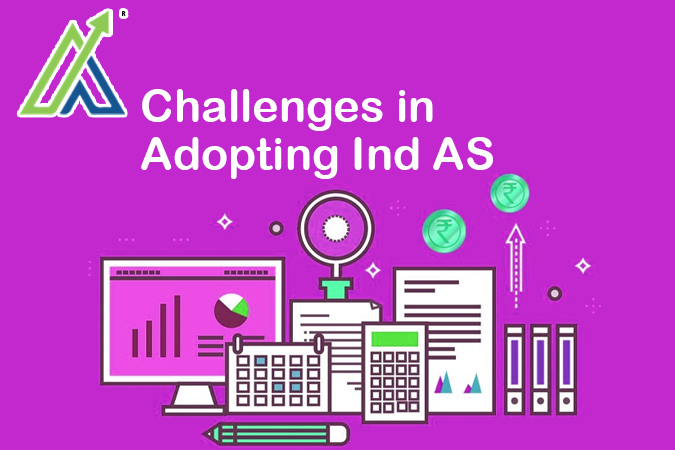Adopting Indian Accounting Standards (Ind AS) is a major step towards synchronizing India’s financial reporting with global practices. But the path to adopting Ind AS is crowded with a lot of challenges. For system updates and vast training, the process can be challenging. This blog will guide you through the challenges and how to overcome them.
Complications of Standards
One of the major challenges on the road to adapting Ind AS is the complexity or complications of standards. Ind AS includes extensive rules that are different from the previous Indian GAAP rules and regulations. For example, Ind AS 115 and 110 need detailed understanding as well as careful execution. Companies usually felt difficulty with the interpretation of these standards for applying them across all financial transactions.
System Updating
Shift to Ind AS needs changes in the system that is used by the company for the purpose of financial statements. Existing systems that are built according to Indian GAAP are not compatible with the new standards, so that is why it is required to make changes to the system or to upgrade the system. This updating leads to more financial investments as well as time and resources.
Training and Skill growth
Adopting Ind AS leads to the requirement of a workforce that can cope with new standards. This leads to ample training for accountants, auditors, and financial specialists. Some companies face challenges because of the short time frame for training. Without executing the proper training, there is more risk of errors in financial reporting. Companies need to keep up with the amendments and updates with respect to standards.
Effect on financial Benchmarks
Switching to the Ind AS can have considerable effects on the financial benchmarks. Alterations in Key Performance Indicators (KPI’s) such as asset valuations, revenue, and profits are performed due to new accounting standards. For instance, Ind AS 115 can change the timing and identification of the revenue, which can impact the declared earnings. These kinds of adjustments make it harder for stakeholders to comprehend the financial statements, thus thorough communication is needed to support the modifications.
Maintaining compliance with regulatory requirements
The shift to Ind AS has created additional challenges in managing regulatory compliance. Ind AS and other local regulatory standards must be complied with by companies in order to prepare financial statements. Double compliance can be challenging and requires more expertise and resources.
Maximize Disclosure requirements
Ind AS commands more disclosures than Indian GAAP. To apply these standards, companies need to provide details of financial operations, performance accountability, and contract balances. Companies with complicated financial structures face difficulties with the required disclosures by Ind AS. More disclosures lead to more time consumption in the preparation of the financial statements.
Stakeholder Communication
Impactful communication is required for the stakeholders while shifting towards Ind AS. Investors, creditors, and stakeholders are required to comprehend how new standards will impact the company’s financial statements as well as performance measures. Clear communication will build trust for the stakeholders and also make them aware of the changes. Investor presentations, reports, and meetings can play an integral part in proper communication.
Questions to Understand your ability
Ques1: What’s one big challenge in adopting Ind AS?
- Easier financial reporting
- Complexity of standards
- Less training needed
- Fewer disclosures
Ques2: Why do companies need to upgrade their systems for Ind AS?
- To cut costs
- To boost employee morale
- Old systems don’t work with Ind AS
- To simplify reports
Ques3: What’s crucial for the workforce during Ind AS transition?
- Knowing only Indian GAAP
- Minimal training
- Lots of training on new standards
- No skill development
Ques4: How can Ind AS 115 mess with a company’s financial benchmarks?
- No impact
- Only changes cash flow
- Alters when and how revenue is recognized
- Simplifies profit calculations
Ques5: What extra challenge comes with regulatory compliance under Ind AS?
- Fewer audits needed
- Double compliance with Ind AS and local rules
- Easier compliance
- No change in requirements
Conclusion
Restoring and adopting Ind AS will be a complex yet necessary process for Indian companies to converge with accounting practices on the subcontinents of the world. System overhauls, extensive training, increased disclosure—all this call for huge challenges but is quite controllable by careful planning and execution. Only if these challenges are carefully seen at this point can companies ensure a seamless transition to Ind AS. This enhanced quality and transparency in financial reporting information will gain stakeholders’ trust. The journey may be tough, but the benefits of adopting Ind AS far outweigh the challenges of paving the way to a more robust and globally aligned financial reporting framework in India.
FAQ's
Ind AS has tons of rules that are way different from old Indian GAAP, making it tough to understand and apply everywhere.
Companies have to update or replace their old financial systems because they don’t fit with Ind AS.
The team needs to learn the new standards well to avoid mistakes in financial reports.
Ind AS can change things like revenue, profits, and asset values. For instance, Ind AS 115 affects when and how revenue is reported.
Because companies have to follow both Ind AS and state rules, they need more resources and knowledge.
Ind AS needs way more details in disclosures, which can be a hassle, especially for complex companies.
Clear and direct communication is key to helping stakeholders understand the changes and build trust.
With more detailed disclosures needed, companies will spend more time making sure everything’s accurate and compliant.

